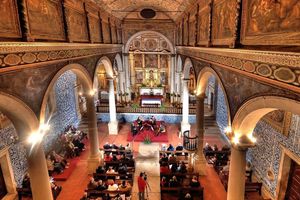
Igreja de Santa Maria Church, Óbidos
Admire the Igreja de Santa Maria church on your stay in Óbidos, Portugal.
The Igreja of Santa Maria lies towards the north of Rua Direita, in the beautiful city of Óbidos, in Portugal.
This is the town’s first church and is erected upon the remnants of a visigothic temple made into a mosque. The building of the church began in the XII century, yet has been restored in several occasions and today most of the building is renaissance style.
The temple became famous in 1444 when King Alfonso V, aged 10, married his cousin Isabel, aged 8.
In the interior, distributed in three naves by two rows of doric columns, it’s worth noting the marvelous painted ceiling and walls decorated with incredible blue tiles dating back to the XVII century and hand painted with vegetable icons. Besides that, the walls are also decorated with twenty oil-paintings by several authors, among them Baltasar Gómez Figueira and Josefa Óbidos.
Right of the altar are exhibited the works of the renown XVII century painter Josefa de Óbidos; whereas towards the left you will find a pantheon, the sepulchre of which (dating back to the XVI century) is renaissance style is crowned by a Pietá accompanied by the Santas Mujeres and Nicodemo as they bury the body of Christ, an extraordinary work attributed to French sculptor Nicolas Chanterène.
The major retable is decorated with eight XVII-century paintings, attributed to João da Costa, representing scenes of the life of Mary.
In the back of the church, former facilities of the town hall, is the Museu Municipal de Óbidos.
More information:
Location:
Praça Santa Maria, Óbidos, Portugal.
Opening times:
From 9:30 to 12:30 and from 14:30 to 19:00.
Recommended Excursions:
Mapa Interactivo:
Óbidos
What to See:
- Castle of Óbidos
- Porta da Vila
- Praça de Santa Maria
- Igreja de Santa Maria Church
- Igreja da Santa Casa da Misericórdia Church
- Igreja de São Pedro Church
- Ermita de Nossa Senhora de Monserrate (Ordem Terceira) Shrine
- Santuário do Senhor Jesus da Pedra Sanctuary
- Capela de São Martinho Shrine
- Igreja de São Tiago Church
- Aqueduct
- Lagoa de Óbidos Lagoon
- Ermita de Nossa Senhora do Carmo Shrine
- Porta do Vale or Senhora da Graça Gate
Museums:
- Igreja de São João Baptista and Museu Paroquial de Óbidos
- Museu Municipal de Óbidos Museum
- Museu Abílio de Mattos e Silva
- Gallery do Pelourinho
- Gallery NovaOgiva
Beaches:
What to Do:
Other worth-visiting nearby towns and cities:
Why "Portugal Travel"?
Portugal Travel is an organization of Portuguese agencies whose objectives are:
- ✓ To make Portugal, its culture and its heritage known.
- ✓ To promote sustainable tourism.
In collaboration with:
Escola Superior de Hotelaria e Turismo do Estoril
Turismo de Portugal
Copyright PortugalTravel.org © - All rights reserved.





